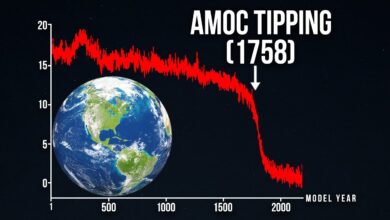James Webb Telescope REVEALS What NASA Tried to HIDE on Mercury, and It’s TERRIFYING!

**Exploring the mysteries of Mercury**
Mercury, the smallest planet in the Solar System, holds many secrets that humans are only beginning to uncover through space missions. Despite its proximity to the Sun, Mercury has surprised scientists with its unusual features, from its unusually large core to its incredibly strong magnetic field.
—
### **Early discoveries: Mariner 10 and MESSENGER**
– **Mariner 10 (1973)** was the first spacecraft to fly by Mercury, recording its cratered surface and strange mountain ranges, similar to those of the Moon. Mariner 10 also discovered that Mercury has a stronger magnetic field and a larger core than originally thought.
– **MESSENGER (2004)** went further as it orbited Mercury and took more than 200,000 images. It shows that the dark side of Mercury contains more calcium and magnesium than expected and sheds light on the planet’s unique formation.
—
### **Unique magnetic field, core and rotation period**
– **Eccentric magnetic field**: Despite being small and rotating slowly, Mercury maintains a strong magnetic field that is about 20% off the center of the planet. This may be related to the uneven thickness of its crust.
– **Strange rotation and orbit**: A year on Mercury lasts only 88 Earth days, while a day on Mercury lasts 176 days. This results in the Sun appearing to stop or go backwards in the sky. This slow rotation period is the result of a phenomenon called the **3:2 resonance**, where Mercury rotates three times on its axis in two orbits around the Sun.
—
### **Extreme temperatures and thin atmosphere**
– Daytime temperatures can reach 430°C, enough to melt lead, while at night they drop to -180°C.
– Mercury’s atmosphere is extremely thin (exosphere) and is constantly lost to space, but is replenished by solar winds and meteorite impacts.
– **Water vapor detected**: In 2020, data from MESSENGER showed that there is water vapor in the atmosphere, formed by hydrogen from the solar wind combining with oxygen in surface rocks.
—
### **Volcanoes and water ice detected at the poles**
– **Volcanic activity**: In 2012, data from MESSENGER detected signs of volcanic eruptions on Mercury, challenging the previous hypothesis that it was geologically “dead”. – **Polar Crater Ice**: The regions permanently shaded from the Sun are still cold enough to retain ice, opening up the possibility of the existence of extremophiles like those on Earth.
—
### **BepiColombo Mission and the Future**
– **BepiColombo (2018-2025)**, a collaboration between ESA and JAXA, promises to provide more detailed information about the geological history and chemical composition of Mercury. The spacecraft will make multiple flybys of Venus and Mercury before slowing down and entering orbit in 2025.
—
**Hypothesis of the Large Core and the Origin of Mercury**
– **Giant Core**: Mercury’s core accounts for 85% of its volume, while Earth’s core accounts for only 15%. The “hit-and-run” hypothesis suggests that Mercury was once a large planet, but was stripped of its outer layers after a collision with a giant celestial body.
– **Unique core structure**: Mercury’s core is mostly liquid with a solid middle, unlike Earth’s. This solid core accounts for nearly 50% of the core’s volume, playing an important role in generating a weak but surprisingly strong magnetic field for such a small planet.
– **Thin crust and volcanic activity**: The planet’s crust is thinner than previously thought (only 420 km). In 2012, MESSENGER discovered “hollows” – shallow pits formed by the evaporation of volatile elements, suggesting that Mercury once contained more of these elements than previously thought.
– **Ancient magma ocean**: A 2020 discovery revealed that Mercury once had a magma ocean, which strongly influenced the planet’s topography and internal structure. The large volcanic plains in the north pole are the result of massive lava flows in the early period.
– **Nitrogen and water ice at the poles**: In 2022, the discovery of subsurface nitrogen suggests Mercury may have once had an atmosphere. Polar craters contain water ice and organic compounds, possibly remnants of comets or meteorites that hit the planet.
– **Tectonic and geologically active**: While Mercury lacks plate tectonics like Earth, it still has large fault lines and may still be geologically active. Young “grabens” (small valleys) suggest the planet’s crust is still shifting.
– **Subsurface water potential**: Some scientists do not rule out the possibility of a deep-seated pocket of liquid water, fueled by residual heat from the core – similar to the underground oceans on moons like Europa and Enceladus.
These discoveries not only help to better understand Mercury, but also provide clues about how the Solar System formed. Future missions may reveal more mysteries, even unexpected ones.








